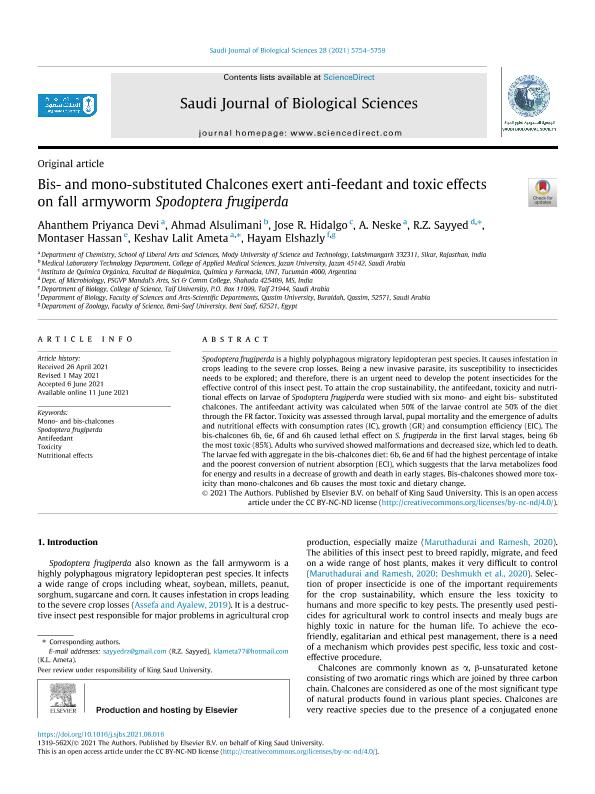Mostrar el registro sencillo del ítem
dc.contributor.author
Priyanca Devi, Ahanthem
dc.contributor.author
Alsulimani, Ahmad
dc.contributor.author
Ruiz Hidalgo, José

dc.contributor.author
Neske, Adriana

dc.contributor.author
Sayyed, R. Z.
dc.contributor.author
Hassan, Montaser
dc.contributor.author
Ameta, Keshav Lalit
dc.contributor.author
Elshazly, Hayam
dc.date.available
2022-09-06T10:42:25Z
dc.date.issued
2021-10
dc.identifier.citation
Priyanca Devi, Ahanthem; Alsulimani, Ahmad; Ruiz Hidalgo, José; Neske, Adriana; Sayyed, R. Z.; et al.; Bis- and mono-substituted Chalcones exert anti-feedant and toxic effects on fall armyworm Spodoptera frugiperda; Elsevier; Saudi Journal of Biological Sciences; 28; 10; 10-2021; 5754-5759
dc.identifier.issn
1319-562X
dc.identifier.uri
http://hdl.handle.net/11336/167460
dc.description.abstract
Spodoptera frugiperda is a highly polyphagous migratory lepidopteran pest species. It causes infestation in crops leading to the severe crop losses. Being a new invasive parasite, its susceptibility to insecticides needs to be explored; and therefore, there is an urgent need to develop the potent insecticides for the effective control of this insect pest. To attain the crop sustainability, the antifeedant, toxicity and nutritional effects on larvae of Spodoptera frugiperda were studied with six mono- and eight bis- substituted chalcones. The antifeedant activity was calculated when 50% of the larvae control ate 50% of the diet through the FR factor. Toxicity was assessed through larval, pupal mortality and the emergence of adults and nutritional effects with consumption rates (IC), growth (GR) and consumption efficiency (EIC). The bis-chalcones 6b, 6e, 6f and 6h caused lethal effect on S. frugiperda in the first larval stages, being 6b the most toxic (85%). Adults who survived showed malformations and decreased size, which led to death. The larvae fed with aggregate in the bis-chalcones diet: 6b, 6e and 6f had the highest percentage of intake and the poorest conversion of nutrient absorption (ECI), which suggests that the larva metabolizes food for energy and results in a decrease of growth and death in early stages. Bis-chalcones showed more toxicity than mono-chalcones and 6b causes the most toxic and dietary change.
dc.format
application/pdf
dc.language.iso
eng
dc.publisher
Elsevier

dc.rights
info:eu-repo/semantics/openAccess
dc.rights.uri
https://creativecommons.org/licenses/by-nc-nd/2.5/ar/
dc.subject
ANTIFEEDANT
dc.subject
MONO- AND BIS-CHALCONES
dc.subject
NUTRITIONAL EFFECTS
dc.subject
SPODOPTERA FRUGIPERDA
dc.subject
TOXICITY
dc.subject.classification
Química Orgánica

dc.subject.classification
Ciencias Químicas

dc.subject.classification
CIENCIAS NATURALES Y EXACTAS

dc.title
Bis- and mono-substituted Chalcones exert anti-feedant and toxic effects on fall armyworm Spodoptera frugiperda
dc.type
info:eu-repo/semantics/article
dc.type
info:ar-repo/semantics/artículo
dc.type
info:eu-repo/semantics/publishedVersion
dc.date.updated
2022-08-29T17:35:46Z
dc.journal.volume
28
dc.journal.number
10
dc.journal.pagination
5754-5759
dc.journal.pais
Arabia Saudita

dc.description.fil
Fil: Priyanca Devi, Ahanthem. Mody University Of Science And Technology; India
dc.description.fil
Fil: Alsulimani, Ahmad. Jazan University; Arabia Saudita
dc.description.fil
Fil: Ruiz Hidalgo, José. Universidad Nacional de Tucumán. Facultad de Bioquímica, Química y Farmacia. Instituto de Química Orgánica; Argentina. Consejo Nacional de Investigaciones Científicas y Técnicas. Centro Científico Tecnológico Conicet - Tucumán; Argentina
dc.description.fil
Fil: Neske, Adriana. Mody University Of Science And Technology; India
dc.description.fil
Fil: Sayyed, R. Z.. Psgvp Mandals Arts; India
dc.description.fil
Fil: Hassan, Montaser. Taif University; Arabia Saudita
dc.description.fil
Fil: Ameta, Keshav Lalit. Mody University Of Science And Technology; India
dc.description.fil
Fil: Elshazly, Hayam. Qassim University; Arabia Saudita
dc.journal.title
Saudi Journal of Biological Sciences
dc.relation.alternativeid
info:eu-repo/semantics/altIdentifier/doi/http://dx.doi.org/10.1016/j.sjbs.2021.06.016
dc.relation.alternativeid
info:eu-repo/semantics/altIdentifier/url/https://www.sciencedirect.com/science/article/pii/S1319562X21004769
Archivos asociados
